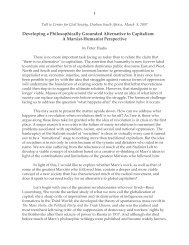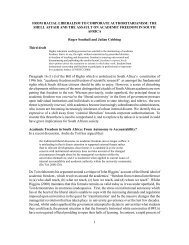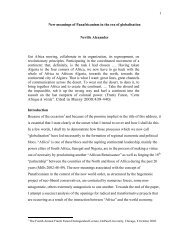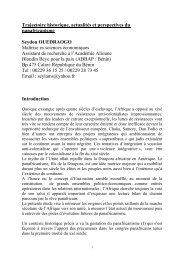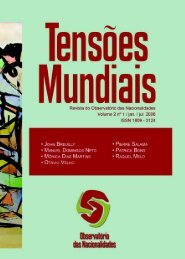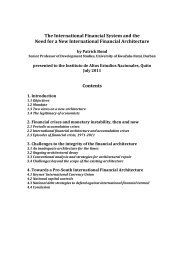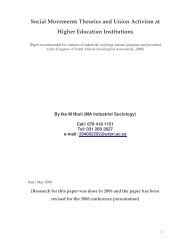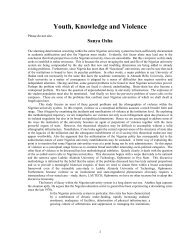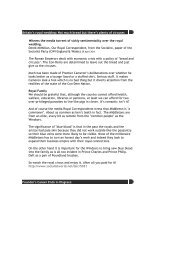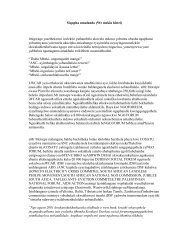The Cape of Good Dope? - Centre for Civil Society - University of ...
The Cape of Good Dope? - Centre for Civil Society - University of ...
The Cape of Good Dope? - Centre for Civil Society - University of ...
Create successful ePaper yourself
Turn your PDF publications into a flip-book with our unique Google optimized e-Paper software.
As Pagad got more militant in its attacks on gangsters and its criticism <strong>of</strong> government,<br />
so the State began to attack Pagad. Gangs also started to fight back. Pagad member,<br />
Faizel Ryklief, was shot after a march on the American’s gang in Bridgetown.<br />
According to Pagad, the police en<strong>for</strong>cement that marches could not cover their faces<br />
(invoking the 1969 Prohibition <strong>of</strong> Disguises Act) made their members vulnerable. <strong>The</strong><br />
open carrying <strong>of</strong> firearms was also seized upon by police and banned. With echoes <strong>of</strong><br />
Fanon (1959), some women turned to veils, which they did not normally wear, to<br />
disguise themselves from gangsters, the veils ensuring they remained visible and<br />
noticed (Fatima Zahra, in Dodd 1996:66).<br />
<strong>The</strong> attacks facilitated Pagad’s drift into small, secretive cells that came to be known as<br />
the G-Force. ‘<strong>The</strong>ir task was to protect - the “G”, purportedly standing <strong>for</strong> guard - the<br />
leadership, but they became the only way that Pagad could operate’ (Jeppie 2000:228).<br />
This was a different Pagad from that described by Father Christopher Clohessy who<br />
‘always perceived the leadership to be in tune with the people. And at times when the<br />
leadership appeared to be losing focus, the response <strong>of</strong> the people appeared sufficient<br />
to bring them back’ (Clohessy 1996:74) Despite Clohessy’s belief that it was<br />
“inconceivable” that there could be two Pagads, this was to become a reality. An<br />
above- and underground Pagad were born.<br />
Mansoer Manuel, a member <strong>of</strong> Pagad’s Grassy Park G-Force cell, who became a NIA<br />
in<strong>for</strong>mer, gave some insights into G-Force operations when giving evidence in court.<br />
He told the court that Abdul-Salaam Ebrahim (Pagad’s Chief Coordinator) referred to<br />
G-Force as Hizbollah, the Army <strong>of</strong> Allah. <strong>The</strong> amier (spiritual leader) <strong>of</strong> his G-Force<br />
cell was Hendricks. Those who disobeyed the amier faced certain death. <strong>The</strong> G-Force<br />
<strong>of</strong> Grassy Park had 20 members. Orders would come after a ‘masoera’, a strategic<br />
planning meeting. Words from the Quran were <strong>of</strong>ten used as a code. For example,<br />
when they spoke <strong>of</strong> the azaan (call to prayer) starting, it meant there had to be a pipebomb<br />
attack.<br />
Manuel spoke about an attack on the Wynberg Synagogue: ‘In December 1998, Mr<br />
Ebrahim sent word that the Grassy Park cell needed to work as they were very quiet.<br />
At first, we were ordered to bomb the Sea Point Synagogue. But the cell felt it was too<br />
dangerous and decided instead to bomb the Wynberg Synagogue’. He described the<br />
unfolding <strong>of</strong> the operation: ‘We referred to the making <strong>of</strong> a pipe bomb as “baking a<br />
cake”. <strong>The</strong> bomb used in the synagogue attack was rectangular and the smallest bomb<br />
we ever made. <strong>The</strong>y prayed on their way to their target. Faried Mohammed (40)<br />
detonated the bomb after struggling to light the cracker fuse . . . <strong>The</strong> first three months<br />
after the NIA agents had recruited me, they telephoned me at least once a week <strong>for</strong><br />
in<strong>for</strong>mation. I eventually gave them in<strong>for</strong>mation and was paid R3 000 every month’<br />
(<strong>Cape</strong> Argus, 10/10/2000).<br />
Even more startling were the revelations <strong>of</strong> the trial <strong>of</strong> the ‘Pagad Four’ who appeared<br />
in the Oudtshoorn Regional Court on explosives, theft and weapons charges in<br />
February 1999. One <strong>of</strong> the four, Ayob Mungalee, revealed himself to be an NIA agent.<br />
This claim was verified by Superintendent Henry Beukes. A NIA spokesman, Helmut<br />
Schlenter, revealed that Mungalee was an in<strong>for</strong>mant not an agent. Police maintained<br />
that Mungalee was an acting NIA member who had been instructed to courier<br />
explosives to <strong>Cape</strong> Town (Mercury, 10 March 1999).<br />
13



